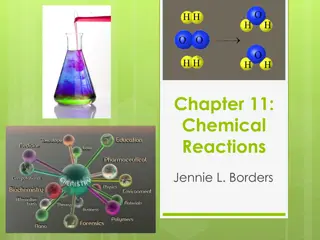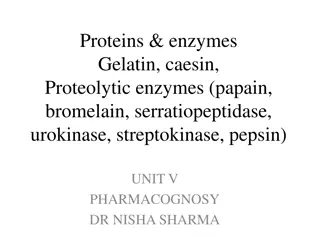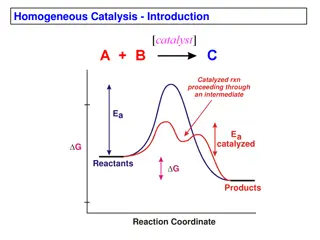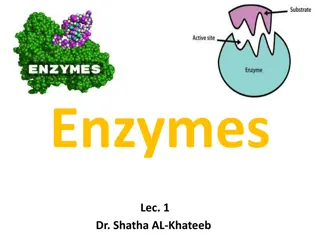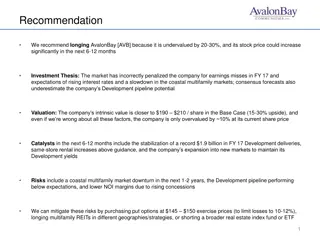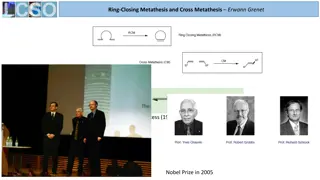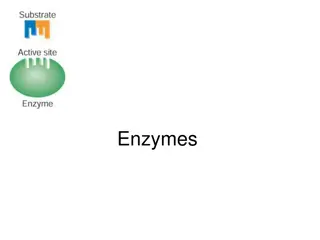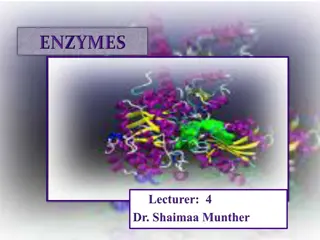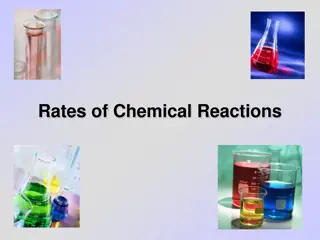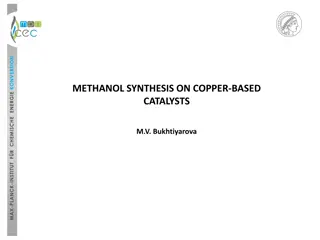Top Catalyst Solutions Companies
The US Catalyst Market Is Poised For Significant Growth In The Next Eight Years. This Exponential Growth Is Driven By The Increasing Demand In The Petroleum Refinery And Chemical Synthesis Industries For Catalysts That Optimize Production And Improve Yield. Simultaneously, There Is A Growing Require
1 views • 5 slides
Grab the Success with the help of Digital Marketing Company
In the fast-paced digital age, where the online landscape is a bustling marketplace of ideas, products, and services, the role of a Digital marketing company is nothing short of pivotal. These companies, armed with a comprehensive arsenal of strategies and a finger on the pulse of digital trends, se
16 views • 7 slides
Understanding Chemical Reactions in Chapter 11
Exploring chemical reactions in Chapter 11 includes describing reactions, using symbols in equations, understanding catalysts, and balancing chemical equations. Various sample and practice problems are provided to enhance comprehension and application of the concepts discussed.
5 views • 70 slides
Enzymes are Proteins that act as Biological Catalyst
Enzymes, as proteins acting as biological catalysts, accelerate chemical reactions without being consumed. They have active sites where substrates bind, and their specificity can be lock-and-key or induced fit. Enzymes are named based on their function or the substrates they interact with. Enzyme sp
5 views • 20 slides
Understanding Enzyme Function Through Induced Fit Model
The learning content discusses enzymes as biological catalysts that increase reaction rates by lowering activation energy. It explores how enzyme activity efficiency is influenced by factors such as temperature, pH, and substrate concentration. The Induced Fit Model is analyzed to explain how enzyme
5 views • 12 slides
Charting Career Paths: The Role of Placement Agencies in Montreal
\"Charting Career Paths: The Role of Placement Agencies in Montreal\" delves into how placement agencies in Montreal act as catalysts, connecting job seekers with diverse opportunities while assisting businesses in finding the perfect talent. These agencies streamline the hiring process, offering pe
5 views • 5 slides
Chemical Kinetics: Understanding Reaction Rates and Factors
Chemical kinetics is a branch of physical chemistry that explores the velocity and factors influencing chemical reactions. It studies how reactants transform into products, considering conditions like temperature, pressure, and reactant concentrations. Factors affecting reaction rates include the na
7 views • 24 slides
Overview of Heavy Chemicals Manufacturing Process
The field of industrial chemistry involves the large-scale preparation of heavy chemicals, which are chemicals produced and used commercially. This process requires an understanding of various physico-chemical principles and specific manufacturing techniques for chemicals like Ammonia, Sulphuric Aci
1 views • 30 slides
Understanding Chemical Reactions: Key Concepts and Practice Problems
Explore the fundamental concepts of chemical reactions, including how reactants and products are represented, the role of catalysts, and writing word equations. Learn through sample and practice problems illustrating different types of reactions. Master writing chemical equations for reactions invol
1 views • 51 slides
Elephant Toothpaste Experiment - Investigating Catalysts in Chemical Reactions
This extended experimental investigation explores the breakdown of hydrogen peroxide using different catalysts to create 'elephant toothpaste.' The experiment aims to determine which catalyst is most efficient at catalyzing the reaction, involving yeast, magnesium dioxide, and potatoes. Background r
0 views • 30 slides
Zeolite Market Automotive Industry Drives
Zeolite Market, By Type (Natural and Synthetic), By Application (Catalysts, Adsorbents, Detergent Builders, Cement, Animal Feed, and Other Applications), By Function, By Region and Companies - Industry Segment Outlook, Market Assessment, Competition
0 views • 3 slides
Overview of Heterogeneous Catalysis and Catalyst Preparation
The development of catalytic processes involves research and development of new catalysts for better activity, selectivity, and stability. This study focuses on preparing new catalysts, determining their properties, and optimizing their development through structure-reactivity relationships. Catalys
5 views • 17 slides
Understanding Nutrients, Vitamins, Minerals, and Water in Your Body
Explore the importance of nutrients, vitamins, minerals, and water in maintaining optimal health. Vitamins play crucial roles in bodily functions, while minerals act as catalysts. Water, a vital nutrient, regulates body functions and carries nutrients while removing waste. Learn about the different
0 views • 5 slides
Understanding Proteins and Enzymes: Classification, Sources, and Applications
Proteins and enzymes play crucial roles in various biological processes. Enzymes act as catalysts, with different types classified based on their functions. Papain enzyme, derived from Carica papaya, exemplifies proteolytic enzymes used in the food and beverage industry as a meat tenderizer and in c
2 views • 15 slides
Empowering Entrepreneurs: Libraries as Catalysts for Business Growth
Libraries play a vital role in supporting entrepreneurs by providing access to resources, knowledge, technology, and networking opportunities. They break down economic barriers, offer free services, and empower underserved populations like women and BIPOC entrepreneurs. From skills development to ex
1 views • 9 slides
Understanding Hard and Soft Acids and Bases (HSAB Principles) by Dr. Gurpreet Kaur
Delve into the world of Hard and Soft Acids and Bases (HSAB) with Dr. Gurpreet Kaur as she explains the characteristics of hard and soft acids, Pearson's HSAB principle, applications such as predictions of coordination in complexes, poisonings of metal catalysts, and the classification of acids and
2 views • 17 slides
Understanding Le Chatelier's Principle in Chemical Equilibrium
Le Chatelier's Principle states that when a system at equilibrium is disturbed by changes in concentration, temperature, or pressure, the equilibrium shifts to counteract the change. This principle can be applied to predict the direction of equilibrium when changes occur. Changes in concentration, p
0 views • 10 slides
Factors Affecting Rates of Reactions and Dissolving Rates
Factors like temperature, surface area, stirring, concentration, pressure, particle size, and catalysts can significantly impact the rates of reactions and dissolving processes. By understanding these factors, one can control and optimize reactions in various chemical and biological systems.
1 views • 10 slides
Understanding Homogeneous Catalysis and Its Advantages
Homogeneous catalysis involves catalyzed reactions proceeding through an intermediate with lower activation energy. This method offers advantages such as selectivity, activity, ease of study, and modification but can be sensitive to deactivation. Comparing with heterogeneous catalysts prevalent in i
0 views • 14 slides
Understanding Enzymes: The Key Catalysts in Biochemical Reactions
Enzymes are biological catalysts that play a crucial role in various life processes by speeding up chemical reactions. They are specific, protein-based molecules that lower the activation energy required for reactions, ensuring proper metabolism and efficiency in living organisms. Factors like pH, t
1 views • 46 slides
Understanding Conflict and Regicide in Macbeth
Explore the themes of ambition, conflict, and regicide in Shakespeare's Macbeth through a detailed analysis of Act 2. Delve into the character motivations, catalysts of conflict, and the consequences of regicide as seen through the murder of King Duncan. Unravel the tensions and complexities that ar
0 views • 12 slides
The DevOps Certifications Transforming Traditional IT Practices
As the IT landscape continues to evolve, the importance of DevOps certifications cannot be overstated. These certifications are more than just a testament to a professional\u2019s skills\u2014they are catalysts for transforming traditional IT practic
3 views • 10 slides
Insights into Coproduced Staff Training Processes and Outcomes
Dive into the reflections, evaluations, and experiences of coproduced staff training by Joanna Dawson and Toni King. Explore themes like safety planning, learning from lived experiences, and the impact of language. Discover the essence of assets, capacity, mutuality, networks, shared roles, and cata
6 views • 23 slides
Understanding Kinetics and Reaction Rates in Chemistry
Kinetics is the study of reaction rates and factors affecting them, such as concentration, temperature, catalysts, and more. Orders of reaction classify reactions based on rate dependency on reactant concentration. Factors like pH, light, and solvents can also impact reaction rates. Half-life and sh
0 views • 18 slides
Understanding Photochemical Reactions in Chemistry
Photochemistry is the study of chemical effects produced by light radiation. It involves different types of chemical reactions such as photochemical and thermal reactions, each influenced by various factors like light, temperature, and catalysts. This article explores the differences between thermoc
0 views • 17 slides
Understanding Chemical Kinetics: Reaction Rates and Mechanisms
Chemical kinetics is a branch of chemistry focused on studying reaction rates and mechanisms. Unlike thermodynamics, which deals with feasibility, kinetics explores the speed at which reactions occur. Factors such as temperature, pressure, and catalysts influence reaction rates. Understanding the ra
3 views • 72 slides
Understanding Enzyme Structure and Function
Enzymes are protein catalysts that accelerate chemical reactions by lowering activation energy. They exhibit substrate specificity and bind to substrates at their active sites. Enzymes may require cofactors for optimal function and can be regulated by various molecules affecting their activity.
0 views • 17 slides
Undervalued Investment Opportunity: AvalonBay (AVB)
Recommended long position in AvalonBay (AVB) due to 20-30% undervaluation and potential stock price increase. Market incorrectly penalized company for past earnings misses and underestimated its development pipeline. Valuation suggests significant upside potential. Mitigate risks with strategic opti
0 views • 9 slides
Understanding Enzymes in Biochemistry: Properties, Specificity, and Regulation
Enzymes are biological catalysts that accelerate biochemical reactions without being altered themselves. They exhibit specificity by binding to particular substrates at active sites to convert them into products. Enzymes can be regulated to match the cell's needs, either through activation or inhibi
1 views • 24 slides
Stock Pitch Competition: Crafting a Winning Investment Thesis
Prepare for a stock pitch competition with the Exeter Student Investment Fund by understanding what makes a strong investment thesis, the importance of catalysts, and how to differentiate your insight for a mispriced stock. Learn the key components of a pitch, from industry and company overview to v
0 views • 14 slides
Building Mental Health Friendly Communities through Faith
Building Mental Health Friendly Communities through Faith explores the intersection of spirituality and mental health care within faith communities. The initiative aims to address health disparities, reduce stigma, and provide support for individuals and families dealing with mental health concerns.
0 views • 11 slides
Clariant Sasol Catalysts Manufacturing Process Overview
This content provides an in-depth look into the manufacturing process of Clariant Sasol Catalysts, covering raw materials such as Polyphosphoric Acid (PPA) and Kieselguhr, as well as the process flow involving dust collection, recycling, steam utilization, and product packaging. The detailed descrip
0 views • 5 slides
Optimal Learning in Laboratory Sciences: Growing Carbon Nanotubes
This tutorial delves into the process of optimal learning in laboratory sciences, focusing on a case study involving the growth of carbon nanotubes. It covers building belief models, running experiments, updating beliefs, designing policies, and optimizing nanotube length using different catalysts w
1 views • 14 slides
Advances in Ring-Closing Metathesis and Cross-Metathesis Catalysts
Recent developments in metathesis catalysts, focusing on Molybdenum and Ruthenium-based catalysts. Comparison of Schrock and Grubbs catalysts, ligands, and new modified catalysts. Details on activity, stability, and group tolerance. The potential of new catalysts like Piers II, Grubbs III, nitro-Gre
0 views • 6 slides
Understanding Enzymes: The Catalysts of Cellular Reactions
Enzymes play a vital role in controlling cellular reactions by speeding up processes without being consumed themselves. They are biological catalysts made of proteins, with each enzyme having a specific shape for its designated molecule. This summary highlights the importance of enzymes in cellular
0 views • 47 slides
Understanding Chemical Reactions and Catalysts
Chemical reactions involve the formation of new substances from reactants, with key processes like oxidation and reduction. Reversible reactions, endothermic and exothermic reactions, and the role of catalysts in speeding up reactions are explored. The significance of chemical symbols, formulas, and
0 views • 8 slides
Understanding Enzymes: Nature's Biochemical Catalysts
Enzymes are highly specific biological catalysts essential for body reactions. Catalyzing the conversion of compounds, they lower activation energy, speeding up reactions without being consumed. Each enzyme has recommended and systematic names, following clear nomenclature by the International Union
0 views • 42 slides
Understanding Rates of Chemical Reactions: Factors and Effects
Rates of chemical reactions are determined by the Collision Theory, which explains how reaction rates are influenced by factors such as concentration, surface area, temperature, catalysts, and stirring. Increasing concentrations, surface area, and temperature generally lead to faster reaction rates,
0 views • 8 slides
Methanol Synthesis on Copper-Based Catalysts at Max Planck Institut
Methanol production using synthesis gas, studying CO2 hydrogenation for reduced CO2 emissions, and utilizing methanol as a hydrogen storage method are key areas of focus at the Max Planck Institut for Chemical Energy Conversion. The process involves methanol synthesis from CO2 and H2, with experimen
0 views • 19 slides
Utilizing Hydrotalcites as Photo Catalysts for Carbon Dioxide Reduction
Burning fossil fuels leads to CO2 emissions, posing a significant environmental challenge. Converting CO2 into valuable hydrocarbons through photocatalytic reduction using solar energy provides a sustainable solution. This process involves multi-electron transfer steps, requiring efficient catalysts
0 views • 24 slides








